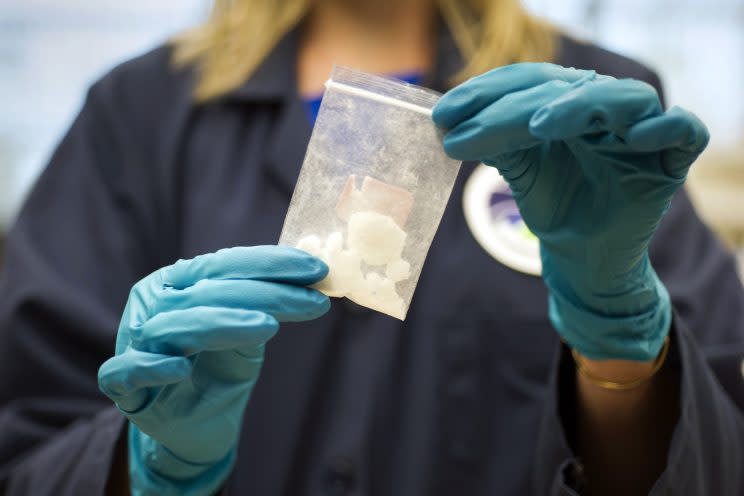First responders face new risk amid opioid crisis: accidental overdose

“No way I’m overdosing,” Officer Chris Green of East Liverpool, Ohio, thought as the strange sensation moved through his body. Green had just returned to his police station after a traffic stop. He had worn gloves and a mask while searching the inside of a vehicle covered in white powder, but when he brushed residue off his shirt with his bare hand an hour later, he fell down and “started talking weird,” he told the Morning Journal. “I slowly felt my body shutting down. I could hear them talking, but I couldn’t respond. I was in total shock.”
The powder was fentanyl, a powerful synthetic opioid that is 50 to 100 times more potent than morphine. It is often used as a pain reliever during surgery or in terminally ill patients, but its popularity has been steadily growing for years in the street-drug market as dealers have begun lacing heroin with fentanyl for more potent highs. Green required four doses of naloxone — a medication that reverses the effects of an opioid overdose — to be completely revived from the exposure. He is now recovering, but the event highlights a new danger in the continuing opioid crisis: the risk to first responders who handle the lethal substances.
East Liverpool Police officer suffers fentanyl overdose from drug call https://t.co/6WKwC8LTFR pic.twitter.com/Fs9tzKAHAf
— WKBN 27 First News (@WKBN) May 15, 2017
Green isn’t the only first responder to be affected by the deadly drugs fentanyl or carfentanil (an analog of fentanyl that is 10,000 times more potent than morphine) while on the job. In 2015, Dan Kallen, a detective in New Jersey, and a fellow officer were brought to the emergency room after accidentally inhaling fentanyl when searching a home of suspected drug users.
Opioids are now the leading cause of accidental death in the U.S. The 33,000 deaths in 2015 were more than there were in any year on record, according to the Centers for Disease Control and Prevention.
While police departments across the country now have safety measures in place — first responders wear gloves and masks when handling the potentially lethal potent drugs. The drugs are so potent accidentally inhaling a granule of the powder or absorbing it through the skin could quickly cause an overdose and/or death. In September, the New Hampshire State Police Forensic Lab released a photo of a lethal dose of heroin next to a lethal dose of fentanyl.

That same month, the Drug Enforcement Agency released a video warning police and the public of the dangers of fentanyl.
“Fentanyl can kill you,” Jack Riley, acting deputy administrator, says in the video. “Fentanyl is being sold as heroin in virtually every corner of our country. It’s produced clandestinely in Mexico, and [also] comes directly from China. It is 40 to 50 times stronger than street-level heroin. A very small amount ingested or absorbed through your skin can kill you.”
Scientists from the National Institute of Standards and Technology are working to address this hazard by analyzing whether technologies like Ion Mobility Spectrometry (IMS) and Direct Analysis in Real Time Mass Spectrometry (DART-MS) can detect trace amounts of fentanyl, even when it has been mixed with heroin and other substances. The technology is already used at airports to alert to detect drugs or explosives; an IMS tool is used to swab luggage or a traveler’s hands. The instruments are extremely sensitive stand-alone devices that can operate under a range of conditions and quickly and accurately detect various substances.
“Currently, police officers have to handle drugs to test them,” said Ed Sisco, a research chemist at NIST and the lead author of the study. “But with these technologies, they can just swab the outside of a bag to test for fentanyl.” If the test comes back positive, officers can take extra precautions.
“It’s a useful tool to understand what level of personal protection the first-responder needs and to know how severe the threat is in the moment,” Sisco told Yahoo News.
On its Facebook page, the city of East Liverpool called on the state of Ohio to take action after Green’s accidental overdose: “It’s time our state government drafts legislation to protect our safety forces from these harmful drugs,” the city representative wrote. “Those in possession not only pose a risk to themselves but everyone they come into contact with as well.”
These drugs “are not only killing the people willing to shove it into their own veins; now they’re killing people like me and my family,” Green told the Morning Journal. “God was surely was looking over me.”
Read more from Yahoo News:


